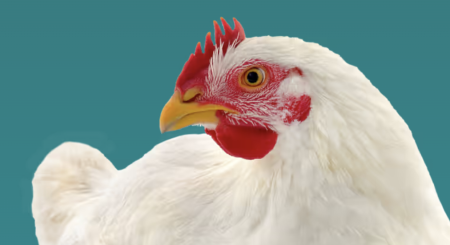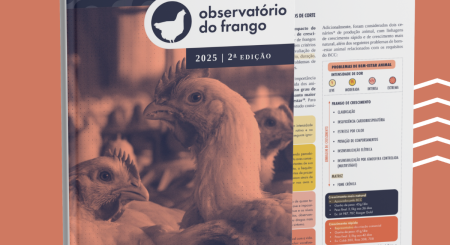According to the Food and Agriculture Organization of the United Nations (FAO), in 2021, 133 million white meats were consumed worldwide. Latin America is the third region that consumes the most chicken meat, and according to FAO data, in 2019, in Brazil, each person consumed an average of 40.6 kg per year. Quite a lot, isn’t it?
However, large-scale consumption also requires large-scale production. So, how does the industry transform this mass production, if chickens need their own time to develop? Have you ever thought about it? We will tell you the path that chicken meat takes until it reaches your plate.
What is Chicken Frankenstein?
The term “Frankenstein Chicken” refers to the industry’s genetically selected creation, made to serve the profits of large companies. These chickens are designed to grow at an accelerated rate and are produced on an industrial scale.
They are programmed to be born, grow and be slaughtered in just 42 days, due to the large consumption of chicken meat in the world. This is a growth rate three times faster than the natural growth rate for the species.
What are the problems associated with Chicken Frankenstein?
Chicken Frankenstein presents several health and welfare issues. Due to their accelerated growth, these birds face metabolic diseases, leg and skin injuries, locomotor problems and a weakened skeleton. Your chest and thighs grow rapidly, causing body imbalances and difficulty moving around.
In addition to these problems, many farms do not manage the floor correctly, which results in the emission of CO2 and ammonia. These pollutants not only affect the breathing of birds, but also of employees who work in these environments.
Watch the video produced by Alianima here , and better understand the problems behind the unhealthy reality to which these animals are subjected.
How are chickens treated by industries?
Unfortunately, chickens are treated like machines by industries, with the sole aim of maximizing profits from chicken meat. They live in overcrowded warehouses, where many don’t even see sunlight or have the chance to perform natural behaviors.
According to IBGE, in 2022 alone , 6.11 billion chickens were raised for slaughter in Brazil. This demonstrates the large volume of industrial production of this type of meat in the country.
Chickens live in unhealthy environments, with no space to explore, socialize or perform natural behaviors such as scratching, perching and bathing in the dirt. These stressful and uncomfortable conditions have a negative impact on your health and well-being.
Watch the video produced by Alianima here , where you can better understand how a healthy routine works for chickens and how this routine is radically interrupted in the production system for slaughter.
How does the slaughter process take place?
The process of slaughtering these chickens is often inhumane and painful. The birds are hung upside down by their legs, causing discomfort and pain, and then their heads are immersed in a vat of electrified water to be stunned.
In many slaughterhouses, poultry treatment is inadequate, resulting in painful electric shocks and unnecessary suffering.
Watch the video produced by Alianima here , and learn more about the slaughter process on farms and how painful and cruel this death can be.
The truth behind chicken meat’s path to your plate is shocking and disturbing. Genetically selected chickens face a cruel and inhumane life, living in overcrowded and unsanitary conditions. They are treated as mere objects in the name of profit, without the chance to express their natural behaviors or explore the environment around them.
We must encourage the implementation of stricter regulations and adequate oversight to ensure that chickens are raised with respect and consideration for their welfare. By raising society’s awareness of the reality of these practices on farms, we can take a step towards a more sustainable and humanized future for all living beings.
Join us in this fight, sign the petition here so that the Federal Government and the Ministry of Agriculture (MAPA) regulate the genetic selection of chickens in Brazil, establishing ethical criteria, and the accelerated growth of chickens in our country comes to an end . We count on you!










